Observation Analysis and Numerical Simulation of the Urban Barrier Effect on Thunderstorm Organization
Abstract
1. Introduction
2. Data and Methodology
3. Results
3.1. Spatial Patterns of Lightning Activity in Built-Up Areas
3.2. Evolution Characteristics of the Thunderstorm Passing over the Built-Up Area of Beijing
3.3. Numerical Simulation of the Influence of the Spatial Configuration of the Building Complex on the Evolution of Dynamic Field
4. Discussion
5. Conclusions
Author Contributions
Funding
Data Availability Statement
Conflicts of Interest
Abbreviations
| LCCs | Large compact-rise clusters |
| SGLNET | State Grid Lightning Network |
| CG | Cloud-to-ground |
| AWS | Automatic weather station |
| CR | Composite reflectivity |
| CFD | Computational fluid dynamics |
| RANS | Reynolds-averaged Navier–Stokes |
| LES | Large eddy simulation |
References
- Dixon, P.G.; Mote, T.L. Patterns and causes of Atlantas urban heat island-initiated precipitation. J. Appl. Meteorol. 2003, 42, 1273–1284. [Google Scholar] [CrossRef]
- Yang, Y.; Guo, M.; Wang, L.; Zong, L.; Liu, D.; Zhang, W.; Wang, M.; Wan, B.; Guo, Y. Unevenly spatiotemporal distribution of urban excess warming in coastal Shanghai megacity, China: Roles of geophysical environment, ventilation and sea breezes. Build. Environ. 2023, 235, 110180. [Google Scholar] [CrossRef]
- Rosenfeld, D.; Woodley, W.L. Deep convective clouds with sustained supercooled liquid water down to −37.5 °C. Nature 2000, 405, 440–442. [Google Scholar] [CrossRef] [PubMed]
- Yang, L.; Li, Q.; Yuan, H.; Ma, R. Impacts of urban canopy on two convective storms with contrasting synoptic conditions over Nanjing, China. J. Geophys. Res. Atmos. 2021, 126, e2020JD034509. [Google Scholar] [CrossRef]
- Bornstein, R.; LeRoy, M. Urban barrier effects on convective and frontal thunderstorms. Preprints. In Proceedings of the Fourth AMS Conference on Mesoscale Processes, Boulder, CO, USA, 25–29 June 1990; pp. 120–121. [Google Scholar]
- Dai, J.; Qin, H.; Zheng, J. Analysis of lightning activity over the Yangtze river delta using TRMM/LIS observations. J. Appl. Meteorol. Sci. 2005, 16, 728–736. [Google Scholar] [CrossRef]
- Meng, W.; Yan, J.; Hu, H. Possible Impact of Urbanization on Severe Thunderstorms over Pearl River Delta. Chin. J. Atmos. Sci. 2007, 31, 364–376. (In Chinese) [Google Scholar] [CrossRef]
- Jin, M.L.; Shepherd, J.M. Inclusion of urban lands CAPE in a climate model: How can satellite data help? Bull. Am. Meteorol. Soc. 2005, 86, 681–689. [Google Scholar] [CrossRef][Green Version]
- Bornstein, R.; Lin, Q. Urban heat islands and summertime convective thunderstorms in Atlanta: Three case studies. Atmos. Environ. 2000, 34, 507–516. [Google Scholar] [CrossRef]
- Lorenz, J.M.; Kronenberg, R.; Bernhofer, C.; Niyogi, D. Urban rainfall modification: Observational climatology over Berlin, Germany. J. Geophys. Res.-Atmos. 2019, 124, 731–746. [Google Scholar] [CrossRef]
- Stallins, J.A.; Bentley, M.L. Urban lightning climatology and GIS: An analytical framework from the case study of Atlanta, Georgia. Appl. Geogr. 2006, 26, 242–259. [Google Scholar] [CrossRef]
- Dou, J.; Wang, Y.; Bornstein, R.; Miao, S. Observed spatial characteristics of Beijing urban climate impacts on summer thunderstorms. J. Appl. Meteorol. Sci. 2015, 54, 94–105. [Google Scholar] [CrossRef]
- Niyogi, D.; Pyle, P.; Lei, M.; Arya, S.P.; Wolfe, B. Urban modification of thunderstorms: An observational storm climatology and model case study for the Indianapolis urban region. J. Appl. Meteorol. Climatol. 2011, 50, 1129–1144. [Google Scholar] [CrossRef]
- Yue, C.; Tang, Y.; Gu, W.; Han, Z.; Wang, X. Study of Urban Barrier Effect on Local Typhoon Precipitation. Meteorol. Mon. 2019, 45, 1611–1620. (In Chinese) [Google Scholar] [CrossRef]
- Kingfield, D.M.; Calhoun, K.M.; de Beurs, K.M.; Henebry, G.M. Effects of city size on thunderstorm evolution revealed through a multiradar climatology of the central United States. J. Appl. Meteorol. Climatol. 2018, 57, 295–317. [Google Scholar] [CrossRef]
- Zhang, N.; Jiang, W.; Wang, X. A numerical simulation of the effects of urban blocks and buildings on flow characteristics. Acta Aerodyn. Sin. 2002, 20, 339–342. [Google Scholar] [CrossRef]
- Hand, L.M.; Shepherd, J.M. An investigation of warm-season spatial rainfall variability in Oklahoma city: Possible linkages to urbanization and prevailing wind. J. Appl. Meteorol. Climatol. 2009, 48, 251–269. [Google Scholar] [CrossRef]
- Chen, L.; Zhang, Y.; Lu, W.; Zheng, D.; Zhang, Y.; Chen, S.; Huang, Z. Performance Evaluation for a Lightning Location System Based on Observations of Artificially Triggered Lightning and Natural Lightning lightning. J. Atmos. Ocean. Technol. 2012, 29, 1835–1844. [Google Scholar] [CrossRef]
- Sun, J.; Yang, B. Meso-β Scale Torrential Rain Affected by Topography and the Urban Circulation. Chin. J. Atmos. Sci. 2008, 32, 1352–1364. [Google Scholar] [CrossRef]
- Xiao, X.; Sun, J.; Chen, M.; Qie, X.; Ying, Z. The characteristics of weakly forced mountain-to-plain precipitation systems based on radar observations and high-resolution reanalysis. J. Geophys. Res. Atmos. 2017, 122, 3193–3213. [Google Scholar] [CrossRef]
- Yang, J.; Huang, X. The 30 m annual land cover dataset and its dynamics in China from 1990 to 2019. Earth Syst. Sci. Data 2021, 13, 3907–3925. [Google Scholar] [CrossRef]
- Ma, S.; Chen, H.; Wang, G.; Zhen, X.; Xu, X.; Li, S. Design and Initial Implementation of Array Weather Radar. J. Appl. Meteorol. Sci. 2019, 30, 1–12. (In Chinese) [Google Scholar] [CrossRef]
- Li, Y.; Ma, S.; Yang, L.; Zhen, X.; Qiao, D. Wind Field Verification for Array Weather Radar at Changsha Airport. J. Appl. Meteorol. Sci. 2020, 31, 681–693. (In Chinese) [Google Scholar] [CrossRef]
- Wilcox, D.C. Turbulence Modeling for CFD; DCW Industries: La Canada, CA, USA, 2006. [Google Scholar]
- Cui, B.; Chen, Y. CFD simulation of curved-roof subjected to thunderstorm downburst. Key Eng. Mater. 2011, 474–476, 1243–1248. [Google Scholar] [CrossRef]
- Shao, J.; Liu, J.; Zhao, J. Evaluation of various non-linear k-ε models for predicting wind flow around an isolated high-rise building within the surface boundary layer. Build. Environ. 2012, 57, 145–155. [Google Scholar] [CrossRef]
- Nelson, M.A.; Brown, M.J.; Halverson, S.A.; Bieringer, P.E.; Annunzio, A.; Bieberbach, G.; Meech, S. A case study of the weather research and forecasting model applied to the joint urban 2003 tracer field experiment. Part 1: Wind and turbulence. Bound. Layer Meteorol. 2016, 158, 285–309. [Google Scholar] [CrossRef]
- Chay, M.T.; Albermani, F.; Wilson, R. Numerical and analytical simulation of downburst wind loads. Eng. Struct. 2006, 28, 240–254. [Google Scholar] [CrossRef]
- Wu, Z.; Yan, T.; Fu, X. CFD Simulation Technology Based Analysis on Urban Wind Environment of Shenzhen. Constr. Qual. 2009, 11, 49–53. [Google Scholar] [CrossRef]
- Li, J. Research on Urban Ventilation Corridor Planning Method Based on CFD Technology; Anhui Jianzhu University: Hefei, China, 2016. [Google Scholar]
- Yuan, C.; Edward, N.G. Building porosity for better urban ventilation in high-density cities-a computational parametric study. Build. Environ. 2018, 50, 176–189. [Google Scholar] [CrossRef] [PubMed]
- Pope, S.B. Turbulent Flows; Cambridge University Press: Cambridge, UK, 2000. [Google Scholar]
- Versteeg, H.K.; Malalasekera, W. An Introduction to Computational Fluid Dynamics: The Finite Volume Method; Pearson Education: London, UK, 2007. [Google Scholar]
- Blocken, B. LES over RANS in building simulation for outdoor and ondoor applications: A foregone conclusion. Build. Simul. 2018, 11, 821–870. [Google Scholar] [CrossRef]
- Richards, P.J.; Hoxey, R.P. Appropriate boundary conditions for computational wind engineering models using the k-ε turbulence model. J. Wind. Eng. Ind. Aerodyn. 1993, 1, 145–153. [Google Scholar] [CrossRef]
- Chen. W. Principles of the Thunder and Lightning; China Meteorological Press: Beijing, China, 2006. (In Chinese) [Google Scholar]
- Li, J.; Song, H.; Xiao, W.; Du, X.; Guo, F. Temporal-spatial characteristics of lightning over Beijing and its circumjacent regions. Trans. Atmos. Sci. 2013, 36, 235–245. (In Chinese) [Google Scholar] [CrossRef]
- Nan, L.; Ming, W.; Niu, B.; Mu, X. A new radar-based storm identification and warning technique. Meteorol. Appl. 2012, 19, 17–25. [Google Scholar] [CrossRef]
- François, B.; Hugo, M. Probabilistic thunderstorm forecasting by blending multiple ensembles. Tellus A Dyn. Meteorol. Oceanogr. 2020, 72, 1–19. [Google Scholar]
- Markowski, P.M.; Straka, J.M.; Rasmussen, E.N. Direct surface thermal-dynamic observations within the rear-flank downdrafts of nontornadic and tornadic supercells. Mon. Weather. Rev. 2002, 130, 1692–1721. [Google Scholar] [CrossRef]
- Westcott, N.E. Summertime cloud-to-ground lightning activity around major midwestern urban areas. J. Appl. Meteorol. 1995, 34, 1633–1642. [Google Scholar] [CrossRef]
- Sun, X.; Luo, Y.; Gao, X.; Wu, M.; Xu, H. On the localized extreme rainfall over the Great Bay Area in south China with complex topography and strong UHI effects. Mon. Weather. Rev. 2021, 149, 2777–2801. [Google Scholar] [CrossRef]
- Mei, S.; Hu, J.; Liu, D.; Zhao, F.; Li, Y.; Wang, Y.; Wang, H. Wind driven natural ventilation in the idealized building block arrays with multiple urban morphologies and unique package building density. Energy Build. 2017, 155, 324–338. [Google Scholar] [CrossRef]
- Steiger, S.M.; Orville, R.E. Cloud-to-ground lightning characteristics over Houston, Texas: 1989–2000. J. Geophys. Res.-Space Phys. 2002, 107, D11. [Google Scholar] [CrossRef]
- Shepherd, J.M.; Burian, S.J. Detection of urban-induced rainfall anomalies in a major coastal city. Earth Interact. 2003, 7, 1–17. [Google Scholar] [CrossRef]
- Wang, Q.; Li, Z.; Guo, J.; Zhao, C.; Cribb, M. The climate impact of aerosols on the lightning flash rate: Is it detectable from long-term measurements? Atmos. Chem. Phys. 2018, 18, 12797–12816. [Google Scholar] [CrossRef]
- Wang, Y.; Lu, G.; Shi, T.; Ma, M.; Wang, Y. Enhancement of cloud-to-ground lightning activity caused by the urban effect: A case study in the Beijing metropolitan area. Remote Sens. 2021, 13, 1228. [Google Scholar] [CrossRef]
- Weisman, M.L.; Klemp, J.B. The structure and classification of numerically simulated convective storms in directionally varying wind shears. Mon. Weather. Rev. 1984, 112, 2479–2498. [Google Scholar] [CrossRef]
- Knaff, J.A.; Seseske, S.A.; Demaria, J.L.; Demuth, J.L. On the influences of vertical wind shear on symmetric tropical cyclone structure derived from AMSU. Mon. Weather. Rev. 2004, 132, 2503–2510. [Google Scholar] [CrossRef]
- Brown, M.E.; Arnold, D.L. Land-surface-atmosphere interactions associated with deep convection in Illinois. Int. J. Climatol. 2015, 18, 1637–1653. [Google Scholar] [CrossRef]
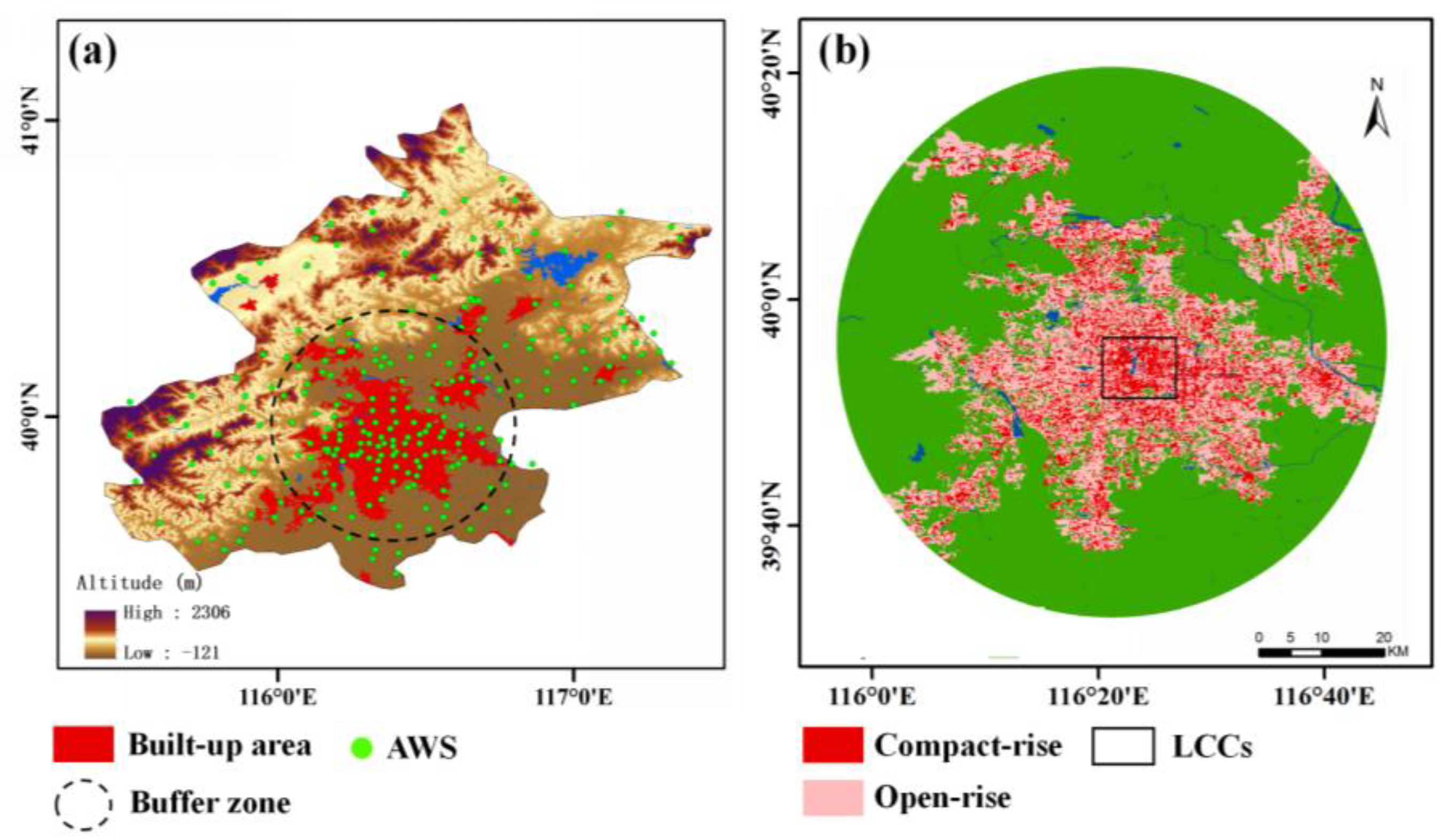
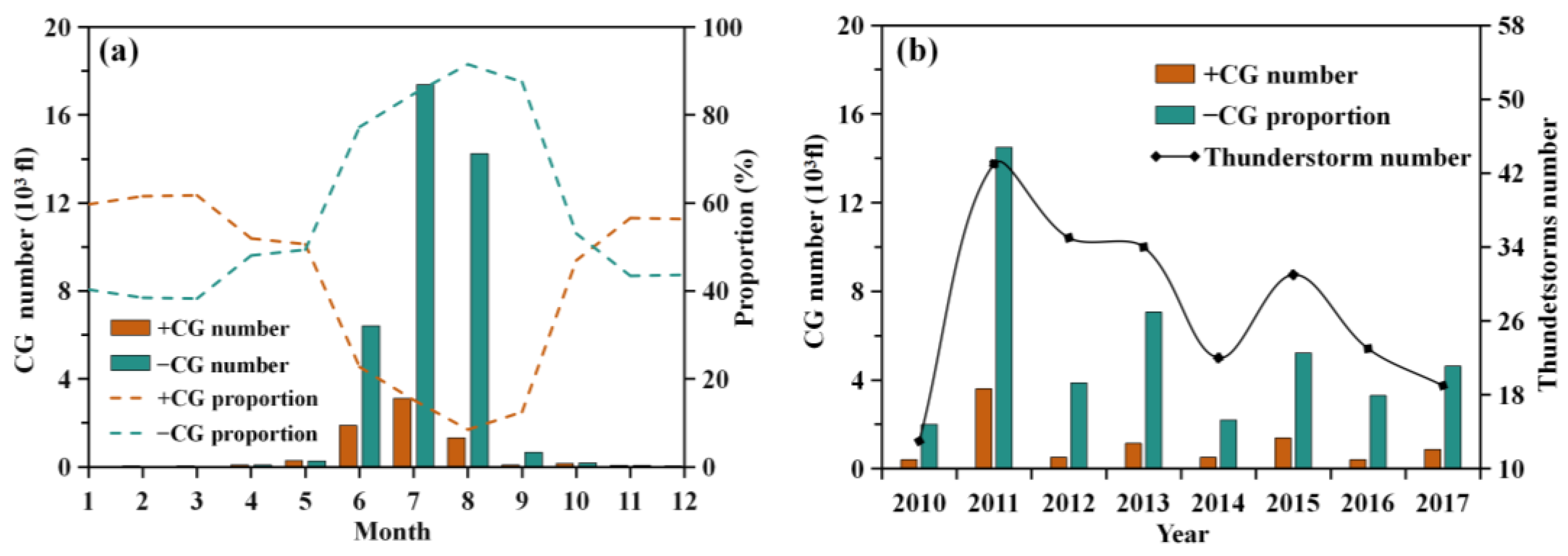
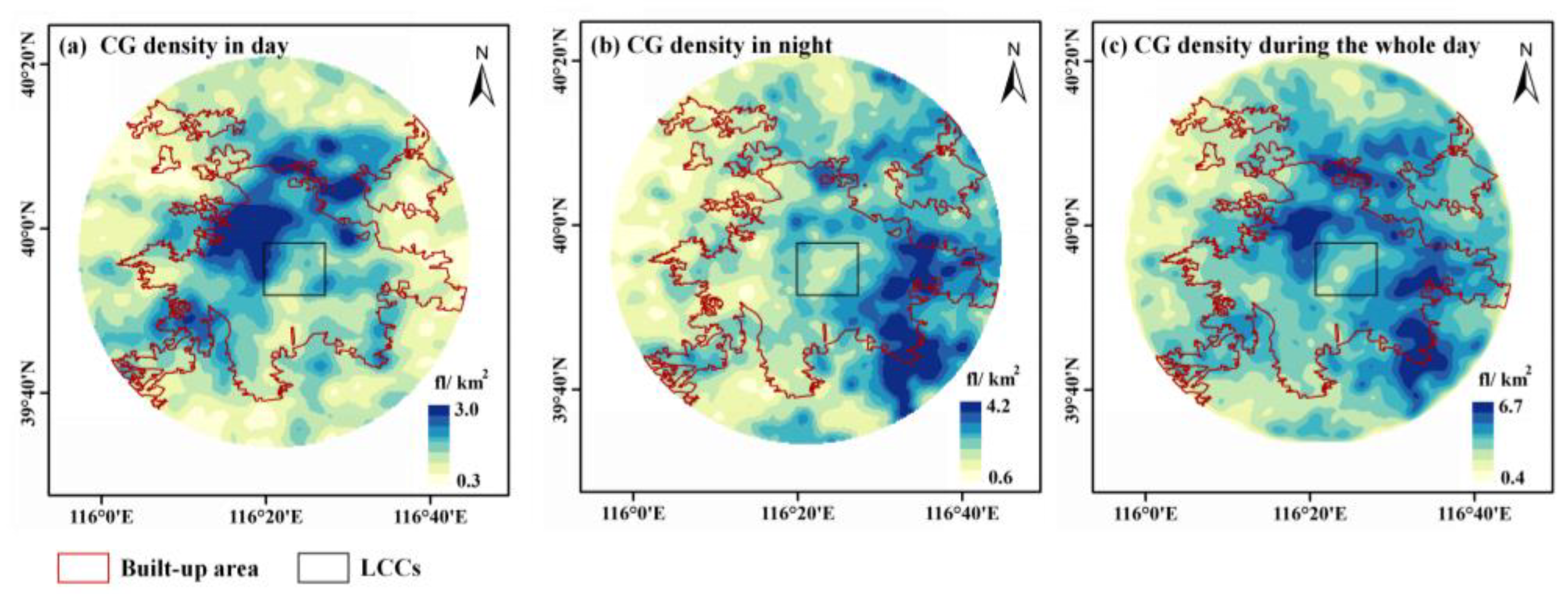


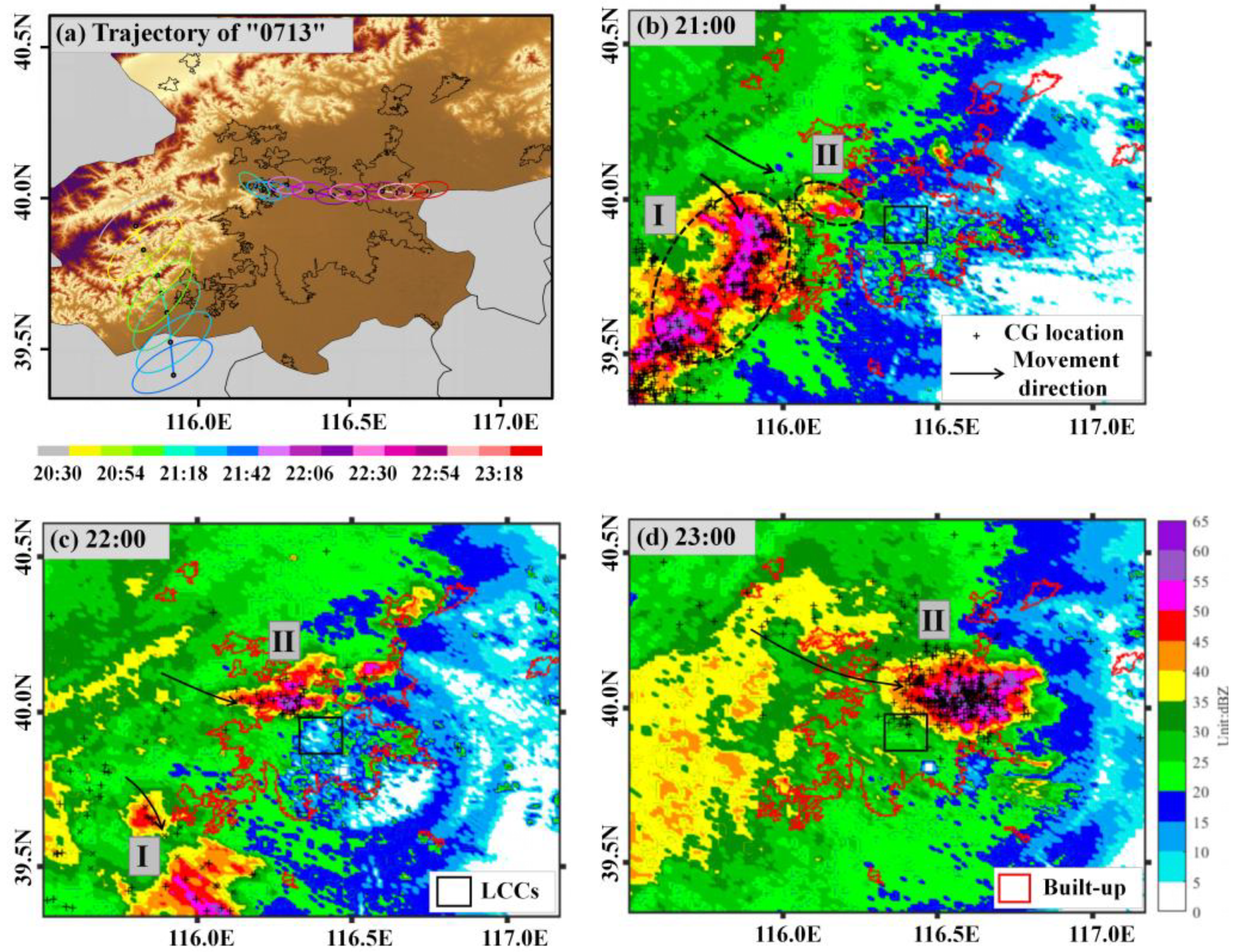


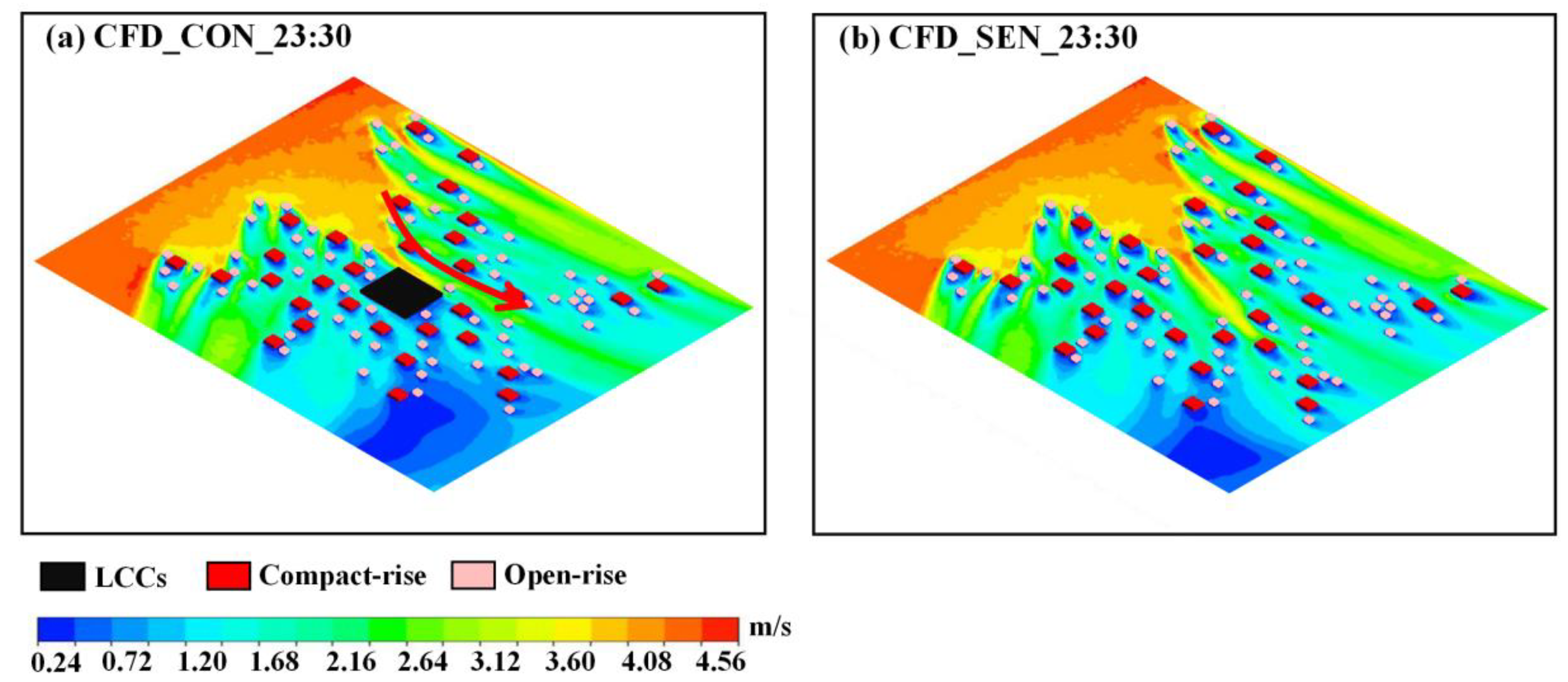

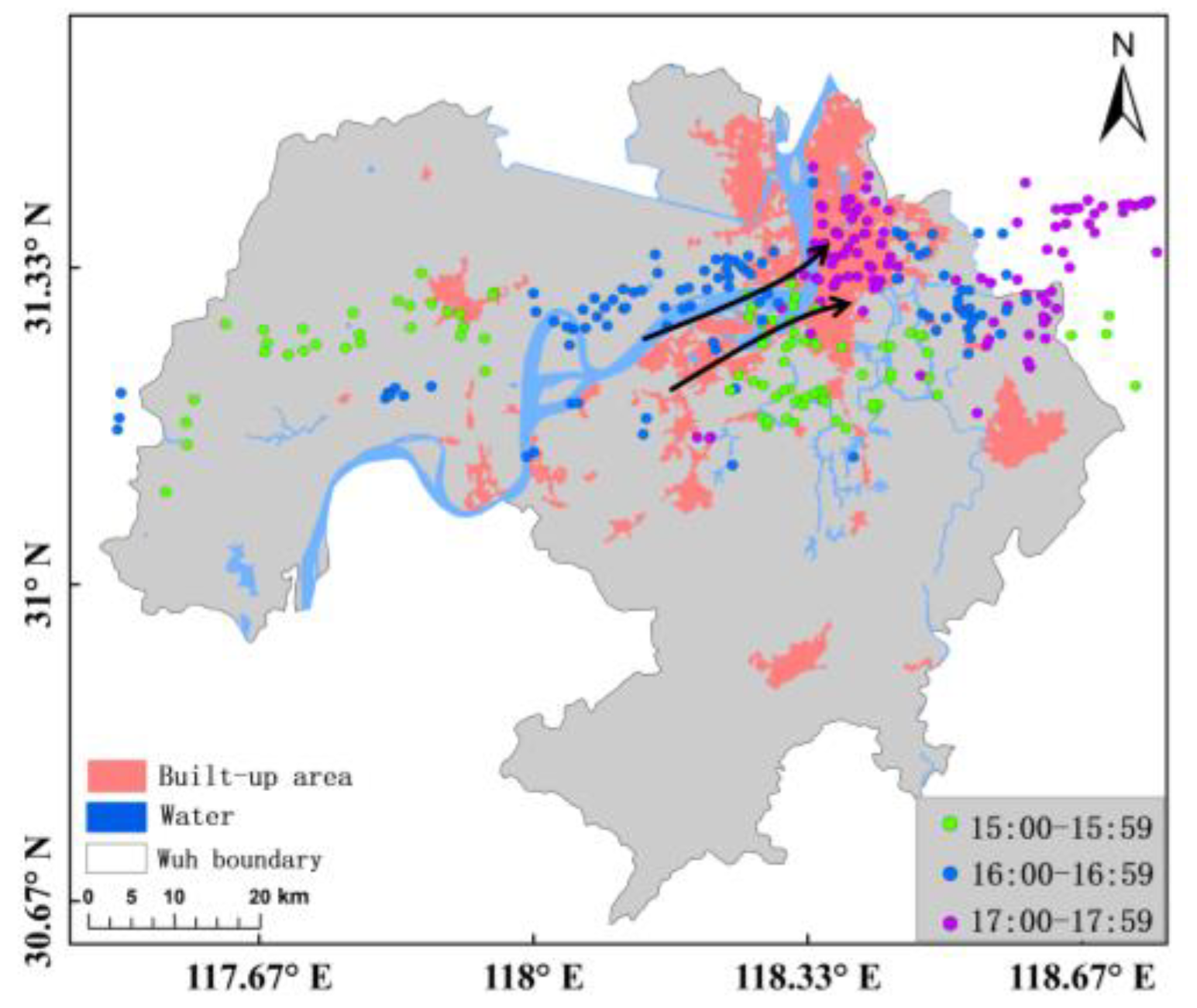


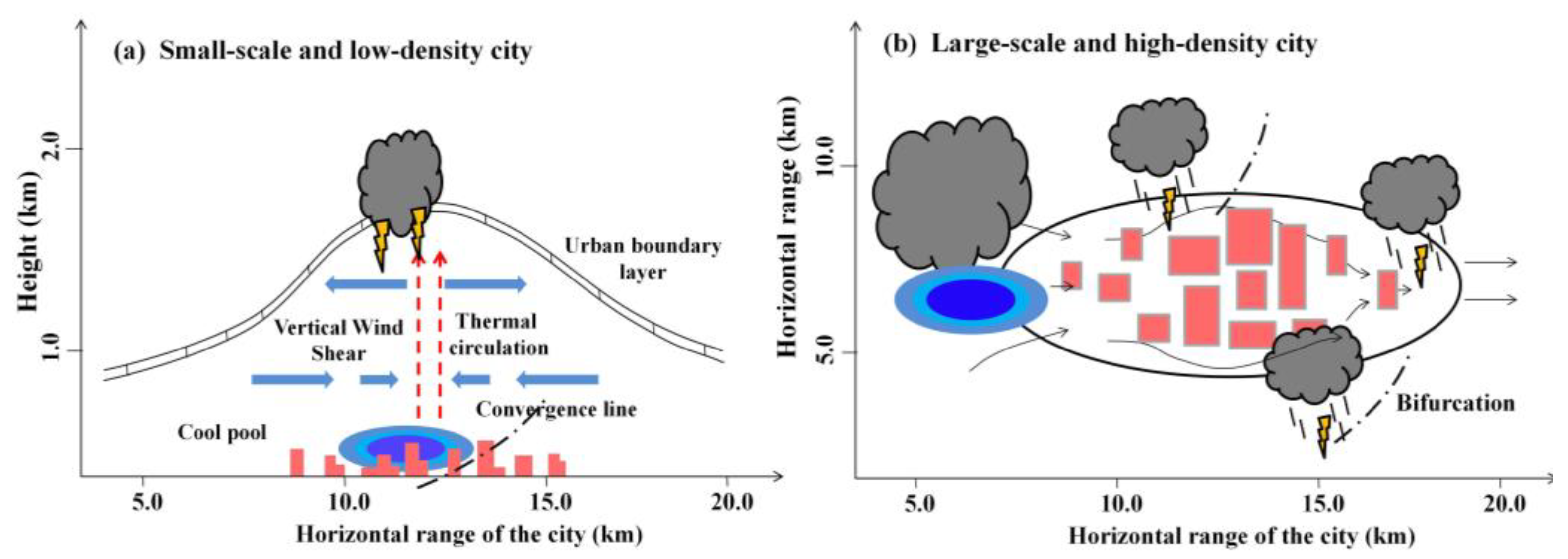
Disclaimer/Publisher’s Note: The statements, opinions and data contained in all publications are solely those of the individual author(s) and contributor(s) and not of MDPI and/or the editor(s). MDPI and/or the editor(s) disclaim responsibility for any injury to people or property resulting from any ideas, methods, instructions or products referred to in the content. |
© 2024 by the authors. Licensee MDPI, Basel, Switzerland. This article is an open access article distributed under the terms and conditions of the Creative Commons Attribution (CC BY) license (https://creativecommons.org/licenses/by/4.0/).
Share and Cite
Shi, T.; Yang, Y.; Lu, G.; Wen, X.; Liu, L.; Qi, P. Observation Analysis and Numerical Simulation of the Urban Barrier Effect on Thunderstorm Organization. Remote Sens. 2024, 16, 1390. https://doi.org/10.3390/rs16081390
Shi T, Yang Y, Lu G, Wen X, Liu L, Qi P. Observation Analysis and Numerical Simulation of the Urban Barrier Effect on Thunderstorm Organization. Remote Sensing. 2024; 16(8):1390. https://doi.org/10.3390/rs16081390
Chicago/Turabian StyleShi, Tao, Yuanjian Yang, Gaopeng Lu, Xiangcheng Wen, Lei Liu, and Ping Qi. 2024. "Observation Analysis and Numerical Simulation of the Urban Barrier Effect on Thunderstorm Organization" Remote Sensing 16, no. 8: 1390. https://doi.org/10.3390/rs16081390
APA StyleShi, T., Yang, Y., Lu, G., Wen, X., Liu, L., & Qi, P. (2024). Observation Analysis and Numerical Simulation of the Urban Barrier Effect on Thunderstorm Organization. Remote Sensing, 16(8), 1390. https://doi.org/10.3390/rs16081390






